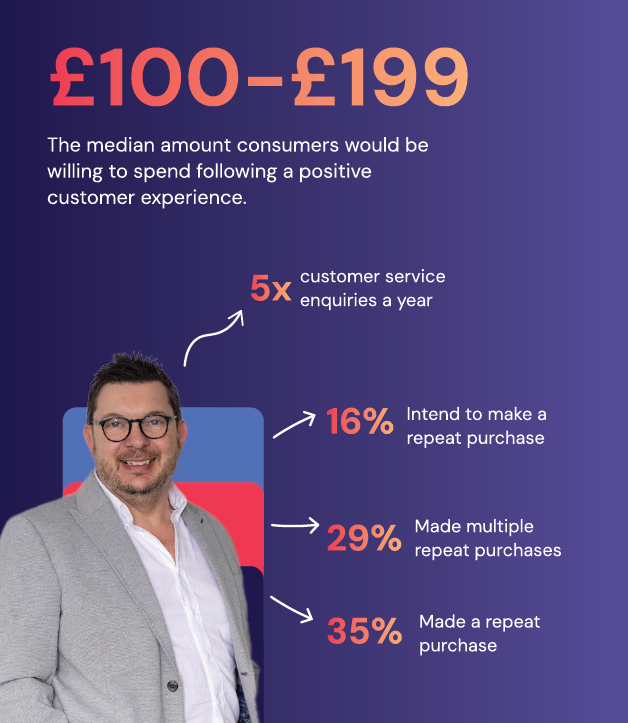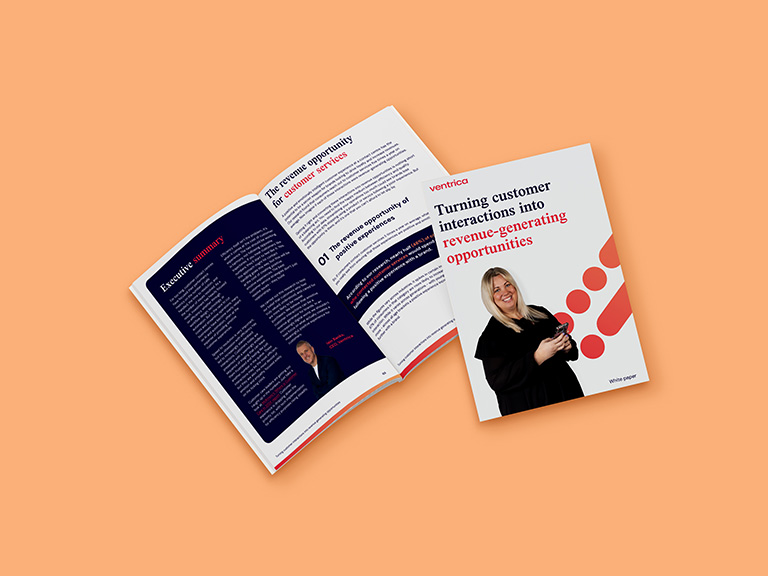How AI is used to transform negative customer contacts into positive ones that build brand loyalty?
Turn negative customer moments into emotive, loyalty-driving experiences. Discover how AI and empathy together transform CX into a powerful engine for growth.
Download our latest white paper- Insights, blogs & articles
Turning tension into trust: how AI transforms negative moments into loyalty-building experiences
Most customer service contacts start with a problem, but that doesn’t mean they have to stay that way. How you respond can define your customers’ relationships with your brand for life.
In this blog, and in our latest whitepaper, we explore how you can use AI to turn these make-or-break moments into revenue and loyalty building opportunities.
Sadly, it’s rare that a customer contacts a brand just to give a compliment, although that would be nice! Customers are far more likely to get in touch or leave a review if they’ve had a poor experience with a brand. But just because a customer has a negative reason for contacting customer services, it doesn’t mean that it has to stay negative. In fact, our data shows that just a single positive experience can directly lead to additional customer spend, up to a whopping £199.
According to our research, well over a third (41%) of enquiries related to an issue were successfully turned into a positive experience. But how did they manage this? Through emotive customer experiences and actually connecting with their customers – here’s how you can do the same and turn those other two thirds into revenue-generating opportunities..
The human touch, but with a bit of help?
Brands are (hopefully) already aware of just how costly a negative customer service experience can be. We found that a whopping 67% of customers would stop using a product or service after a negative experience. With the majority of contacts coming as a result of a poor experience, it’s essential that brands can turn these around.
In our research, we found that the majority (76%) of positive experiences were delivered by a human. This makes sense, humans connect best with other humans, not chatbots or automated systems. But, relying solely on human agents is simply impractical due to the sheer amount of interactions they have to deal with on a daily basis. Even for smaller brands, with the average consumer contacting customer services five times a year, the numbers soon pile up.
Not to mention that the average customer is tired of repeating their issue over and over again to various customer service agents every time they call up. It’s clear that human agents can’t keep up on their own anymore. Yes, brands have tried in the past to address this by introducing automated systems but more often than not, these are clunky and reroute most of the calls to the wrong department entirely.
When we asked what made a customer service interaction positive for them, ‘a quick resolution’ was by far the most popular with 69% choosing it. But if you add this to the experience most customers are having now, it doesn’t add up. For most, the customer service experience is clunky and rushed, leaving little room to turn negative experiences into positive ones.

AI in shining armour
To successfully turn negative experiences into positive ones , brands should be swapping out outdated tools in favour of AI tools that can accurately assess what the problem is.
After ‘a quick resolution’, ‘the representative showed empathy and understanding’ was the second most popular factor that made a customer service interaction positive. So, by using AI tools to solve the issue of effective triaging and speed, brands should free up time for their human agents to connect with customers emotionally as they solve their issues.
These AI tools can even pass on any helpful information from the triaging stage to customer service agents, meaning they can skip all of the boring questions and get on with the solution – minimising frustration for both the agent and the customer.
With less time wasted on fact-finding, human agents can focus entirely on delivering an emotive experience that focuses solely on the solution and turning a negative to a positive in the process.
AI taking over?
But of course, there’s the widely held misconception for customers around AI chatbots and automated systems. Gartner says that 64% of consumers would prefer that brands didn’t use AI in customer services. But, this could well be down to poor experiences in the past with those previously mentioned clunky and awkward systems.
Despite this, while the majority of customers (82%) still prefer to place a call to customer services, they aren’t actually completely against using other channels. We found that email and chatbots were surprisingly popular amongst consumers, with 75% and 65% respectively using them.
So it is possible to integrate AI without alienating customers. These alternatives are precisely where AI analytical tools can be implemented in the most non-invasive way possible for the consumer. Acting not as a barrier to speaking to a human agent, but as a gateway to speaking to the right human agent instead.
Once they’ve experienced it done right, we think they’ll reassess their opinion of AI in customer services.
Turning loyalty into revenue
It’s clear that putting the work in to turn negative experiences into positive ones can benefit more than just your CSAT score. According to our research, over half (53%) of consumers make a repeat purchase following a positive customer service experience. Implementing AI tools won’t just build loyalty, they could unlock a not-insignificant additional pot of revenue that is currently sitting untapped within your existing customer experience interactions.
Investing in these tools might be an upfront cost, but a truly combined human and AI customer service centre set-up could be invaluable in the long term. That aforementioned additional spend is on average worth £100 and £199. Now imagine that multiplied by that 31% of negative interactions….
Ultimately, using the right blend of human customer service agents and AI tools to support them, brands can supercharge their customer service. Not only delivering emotive customer experiences and turning negative into positive, but also an additional revenue stream currently sitting untapped beneath their noses.
A missed opportunity isn’t just a complaint – it’s potentially £199 walking away
By transforming just 10% more negative contacts into positive ones, mid-size brands could see six-figure gains annually – all by empowering their people with smarter tools.
So how can they do that? Well, at Ventrica, we help brands blend emotionally intelligent agents with advanced AI tools – turning every customer touchpoint into an opportunity to rebuild trust and unlock growth. We’ve got more than a little bit of expertise in the area and we think there are three essential steps that every brand should take to unlock some of this revenue and turn more of their negatives into positives.
- Use AI to listen smarter: The first step to take is to ensure you’re effectively using AI triaging tools to accurately understand your incoming queries. It will immediately and drastically improve your service speeds, with customers no longer being bounced around multiple departments before getting to the right one.
- Free up your customer service agents: AI can’t solve everything. But when your customers are inevitably passed over to a human, use AI to make that handover cohesive. It can summarise all of their interactions, giving your agents valuable insights and allowing them to focus their efforts on providing emotional support and developing genuine connections.
- Learn as much as you can: AI is a journey, not a one-and-done. It never stops learning, so it’s essential you keep feeding in information so it can keep refining its approach. Ensure that you feed it the outcomes of all your queries, positive and negative, by building a feedback loop.
Want to turn complaints into conversions? Check out our new whitepaper to find out how AI and empathy combined can level up your customer experience setup to unlock extra revenue, retention, and reputation.

Iain Banks
CEO
